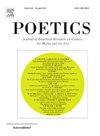还是巴赫、贝多芬和勃拉姆斯?对21世纪初德国和美国古典管弦乐事实上的经典的计算观点
IF 1.7
2区 社会学
0 LITERATURE
引用次数: 0
摘要
古典音乐交响乐团对德国和美国的文化舞台都至关重要。尽管关于音乐典范、性别平等和曲目创新的讨论一直在进行,但关于两国古典音乐作品的实际演出频率的实证研究却很少。在本研究中,我们通过网络搜刮收集了 2019/20 和 2023/24 乐季专业交响乐团的音乐会节目单,并利用数据链接从各种在线资源中丰富了元数据。除了详细的描述性统计分析外,我们还利用随机森林模型确定了舞台演出频率的关键因素。在这些因素的基础上,我们使用潜类分析法确定了典型剧目类型。随后,使用混合回归法确定了这些剧目中单个作品舞台成功的内部因素。结果表明,在德国,规范性标准往往对节目选择起着决定性作用,而美国则更倾向于流行性标准。主要根据作品和艺术家的声望、作品的年龄和作品的持续时间,划分出四种曲目类型。总体而言,美国的节目似乎更加多样化和创新,对两国节目数据进行大流行前和大流行后的综合比较,发现两国的差异不大。这些实证结果支持并扩展了以往对卡农的音乐学研究,可作为文化政策的导向知识。此外,未来的研究还可以利用现有的数据集来考察古典音乐会活动的策划方式,并对子曲目进行更精细的分析。本文章由计算机程序翻译,如有差异,请以英文原文为准。
Bach, Beethoven and Brahms again? A computational view on the de facto canon of classical orchestral music in Germany and the USA at the beginning of the 21st century
Classical music orchestras are vital to the cultural scenes of both Germany and USA. Despite ongoing discussions on musical canon, gender equality, and repertoire innovation, empirical studies on the actual frequency of performances of individual classical music works in both countries are scarce. In this study, concert programs of professional orchestras from the 2019/20 and 2023/24 seasons were collected via web scraping and enriched with metadata from the various online sources using data linkage. In addition to a detailed descriptive statistical analysis, we determined key factors of stage performance frequency using random forest models. Based on these factors, canonical repertoire types were then identified using Latent Class Analysis. Internal factors for stage success of individual works from these repertoires were subsequently determined using Mixture Regression. Results suggest that normative criteria tend to play a more decisive role for program selection in Germany, while the USA lean more towards popular criteria. Four repertoire types are distinguished, primarily based on work and artist prestige, work age and work duration. Generally, programming in the US appears to be more diverse and innovative, and a pre- and post-pandemic comparison of the combined program data from the two countries reveals little differences. These empirical results support and expand on previous musicological studies of canon and can serve as orientation knowledge for cultural policy. Furthermore, the available dataset can also be used by future studies to examine the ways of curating classical concert events and for more fine-grained sub-repertoire analyses.
求助全文
通过发布文献求助,成功后即可免费获取论文全文。
去求助
来源期刊

Poetics
Multiple-
CiteScore
4.00
自引率
16.00%
发文量
77
期刊介绍:
Poetics is an interdisciplinary journal of theoretical and empirical research on culture, the media and the arts. Particularly welcome are papers that make an original contribution to the major disciplines - sociology, psychology, media and communication studies, and economics - within which promising lines of research on culture, media and the arts have been developed.
 求助内容:
求助内容: 应助结果提醒方式:
应助结果提醒方式:


